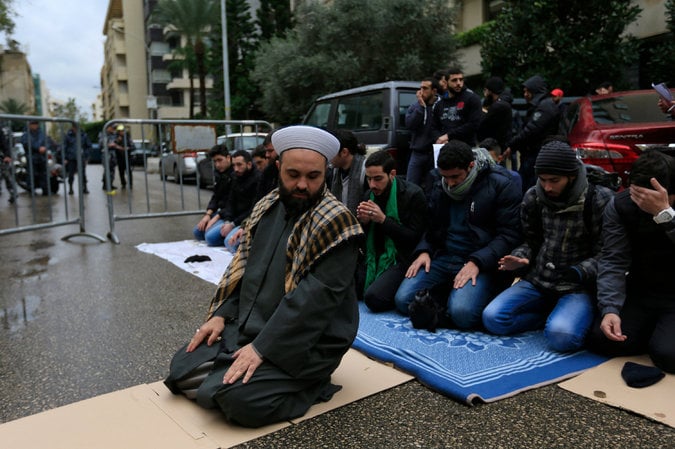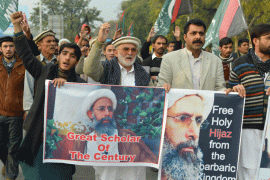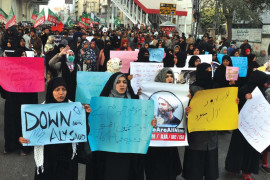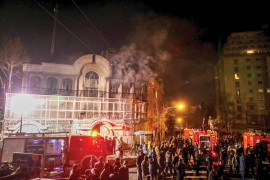
Saudi Arabia says 47 executed on terror charges, including top Shia cleric
Here is a primer on the basic differences between Sunni and Shia Islam.
What caused the split?
A schism emerged after the death of the Prophet Muhammad (PBUH) in 632. He died without appointing a successor to lead the Muslim community, and disputes arose over who should shepherd the new and rapidly growing faith.
Some believed that a new leader should be chosen by consensus; others thought that only the Prophet (PBUH)’s descendants should become caliph. The title passed to a trusted aide, Hazrat Abu Bakr, though some thought it should have gone to Hazrat Ali, the Prophet (PBUH)’s cousin and son-in-law. Hazrat Ali eventually did become caliph after Hazrat Abu Bakr’s two successors were assassinated.
Saudi embassy attacked in Tehran: news agency
 Shia pilgrims at the shrine to Imam Hussein in Karbala, Iraq, in December. Each year millions visit the city to mark Arbaeen, the end of the 40-day mourning period for Imam Hussein, one of Shia Islam's most revered figures. PHOTO: AP
Shia pilgrims at the shrine to Imam Hussein in Karbala, Iraq, in December. Each year millions visit the city to mark Arbaeen, the end of the 40-day mourning period for Imam Hussein, one of Shia Islam's most revered figures. PHOTO: APAfter Hazrat Ali also was assassinated, with a poison-laced sword at the mosque in Kufa, in what is now Iraq, his sons Imam Hasan and then Imam Hussein claimed the title. But Imam Hussein and many of his relatives were massacred in Karbala, Iraq, in 680. His martyrdom became a central tenet to those who believed that Hazrat Ali should have succeeded the Prophet (PBUH). (It is mourned every year during the month of Muharram.) The followers became known as Shia, a contraction of the phrase Shiat Ali, or followers of Ali.
Shia anger after Saudi Arabia executes top cleric
The Sunnis, however, regard the first three caliphs before Hazrat Ali as rightly guided and themselves as the true adherents to the Sunnah, or the Prophet (PBUH)’s tradition. Sunni rulers embarked on sweeping conquests that extended the caliphate into North Africa and Europe. The last caliphate ended with the fall of the Ottoman Empire after World War I.
How do their beliefs differ?
The Sunni and Shia sects of Islam encompass a wide spectrum of doctrine, opinion and schools of thought. The branches are in agreement on many aspects of Islam, but there are considerable disagreements within each. Both branches include worshipers who run the gamut from secular to fundamentalist. Shia consider Hazrat Ali and the leaders who came after him as imams. Most believe in a line of 12 imams, the last of whom, a boy, is believed to have vanished in the ninth century in Iraq after his father was murdered. Shias known as Twelvers anticipate his return as the Mahdi, or Messiah. Because of the different paths the two sects took, Sunnis emphasize God’s power in the material world, sometimes including the public and political realm, while Shia value in martyrdom and sacrifice.
Saudi Arabia to face ‘divine revenge’ over cleric’s execution: Khamenei
Which sect is larger, and where is each concentrated?
More than 85 per cent of the world’s 1.5 billion Muslims are Sunni. They live across the Arab world, as well as in countries like Turkey, Pakistan, India, Bangladesh, Malaysia and Indonesia. Iran, Iraq and Bahrain are largely Shia. The Saudi royal family, which practices an austere and conservative strand of Sunni Islam known as Wahhabism, controls Islam’s holiest shrines, Makkah and Madinah. Karbala, Kufa and Najaf in Iraq are revered shrines for the Shias.
Saudi Arabia and Iran, the dominant Sunni and Shia powers in the Middle East, often take opposing sides in regional conflicts. In Yemen, Shia rebels from the north, the Houthis, overthrew a Sunni-dominated government, leading to an invasion by a Saudi-led coalition. In Syria, which has a Sunni majority, the Alawite Shia sect of President Bashar al-Assad, which has long dominated the government, clings to power amid a bloody civil war. And in Iraq, bitter resentments between the Shia-led government and Sunni communities have contributed to victories by the Islamic State.
This article originally appeared on the New York Times, a partner of The Express Tribune.











































COMMENTS (22)
Comments are moderated and generally will be posted if they are on-topic and not abusive.
For more information, please see our Comments FAQ